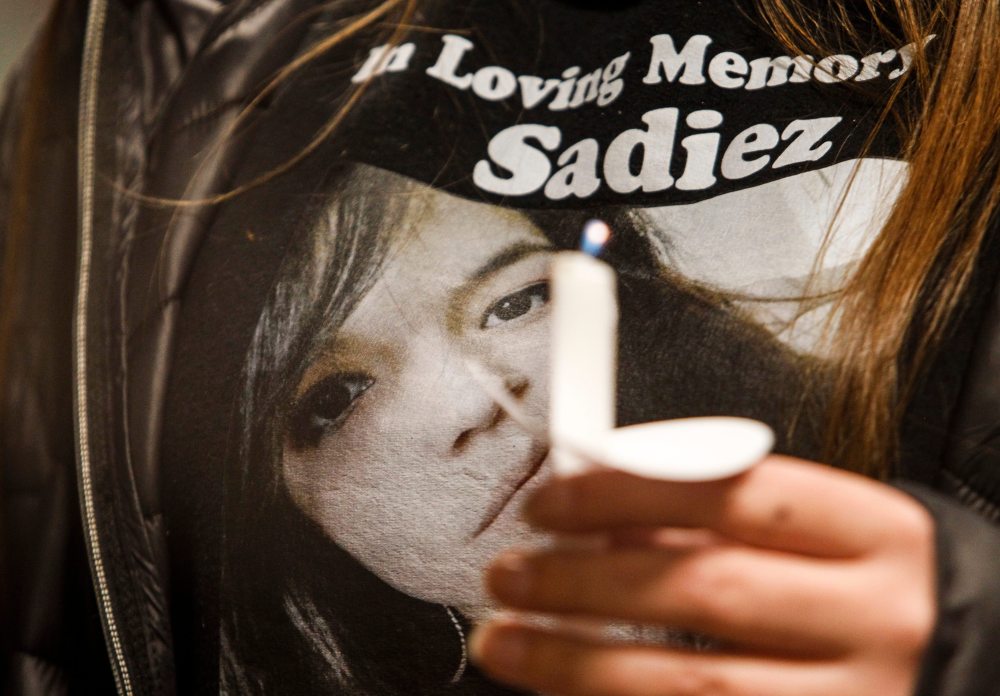Indigenous cultural symbols, traditional practices inside courtroom honour accused serial killer’s alleged victims
Read this article for free:
or
Already have an account? Log in here »
To continue reading, please subscribe:
Monthly Digital Subscription
$0 for the first 4 weeks*
- Enjoy unlimited reading on winnipegfreepress.com
- Read the E-Edition, our digital replica newspaper
- Access News Break, our award-winning app
- Play interactive puzzles
*No charge for 4 weeks then price increases to the regular rate of $19.00 plus GST every four weeks. Offer available to new and qualified returning subscribers only. Cancel any time.
Monthly Digital Subscription
$4.75/week*
- Enjoy unlimited reading on winnipegfreepress.com
- Read the E-Edition, our digital replica newspaper
- Access News Break, our award-winning app
- Play interactive puzzles
*Billed as $19 plus GST every four weeks. Cancel any time.
To continue reading, please subscribe:
Add Free Press access to your Brandon Sun subscription for only an additional
$1 for the first 4 weeks*
*Your next subscription payment will increase by $1.00 and you will be charged $16.99 plus GST for four weeks. After four weeks, your payment will increase to $23.99 plus GST every four weeks.
Read unlimited articles for free today:
or
Already have an account? Log in here »
Hey there, time traveller!
This article was published 07/11/2023 (763 days ago), so information in it may no longer be current.
With her identity still a mystery, a red dress has been draped over a Winnipeg courtroom chair to represent one of four alleged victims of an accused serial killer at a pre-trial hearing.
The room at the downtown Law Courts was smudged, a prayer and song were conducted, and prayer ties were hung from all four walls before formal proceedings began Monday.
The inclusion of sacred First Nations traditions and modern missing and murdered Indigenous women and girls symbols in a typical Manitoba courtroom was very rare and an important step forward, said Marc Kruse, director of Indigenous legal learning and services in the University of Manitoba’s law school.

“It is a sign that the Manitoba courts are taking Indigenous legal traditions seriously, trying to work toward reconciliation and trying to fuse Indigenous legal tradition and common law tradition,” said the criminal defence lawyer, who is not involved in accused serial killer Jeremy Skibicki’s case.
“Hopefully, these are first steps toward the judiciary making an Indigenous court.”
A Manitoba government spokesman said the creation of Indigenous court spaces in Winnipeg, Thompson and Dauphin is a “critical step” in the province’s commitment to reconciliation and efforts to decolonize criminal justice systems.
The courts are being developed in collaboration with Indigenous communities, the spokesman said.
An Indigenous justice system was recommended by the Aboriginal Justice Inquiry’s final report in 1991. An implementation commission cited inequality, injustice, discrimination and an air of colonialism within the provincial system about a decade later.
Indigenous people are over-represented in Canada’s justice system.
The involvement of First Nations traditions in court was welcomed by Assembly of Manitoba Chiefs Grand Chief Cathy Merrick.
“Respecting and accommodating First Nations’ traditions in court proceedings is an act of cultural respect,” she said in a statement. “It recognizes the unique culture and customs of First Nations people, promoting understanding and inclusivity within the legal system.
“Recognizing and accommodating these traditions reflects the coexistence of different legal systems, beliefs and customs. It’s a real step toward reconciliation that should be available to all First Nations citizens in the province of Manitoba.”
Skibicki is charged with four counts of first-degree murder in the 2022 deaths of four Indigenous women — Rebecca Contois, Morgan Harris, Marcedes Myran and an unknown woman temporarily named Mashkode Bizhiki’ikwe, or Buffalo Woman, by Indigenous community members.
Requests for ceremony and traditions were raised by the Crown, which speaks for the victims and their families, said Manitoba Courts spokeswoman Aimee Fortier.
She said the “accommodations and gestures” were agreed to by all counsel and conducted in a way to preserve neutrality while incorporating Indigenous knowledge, practice and tradition.
“It is a sign that the Manitoba courts are taking Indigenous legal traditions seriously, trying to work toward reconciliation and trying to fuse Indigenous legal tradition and common law tradition,” – Marc Kruse
The red dress, placed on a front-row seat in the court gallery, was present when the hearing of pre-trial motions continued Tuesday. Red dresses have become a symbol of missing and murdered Indigenous women and girls.
A buffalo headdress, which also represents the unidentified woman, was placed on a table in front of Crown counsel.
The coloured ties on the walls represent the four directions. They are meant to hold thoughts and prayers for the duration of the two-week hearing, Crown attorney Chris Vanderhooft told court Monday.
He said the room was smudged to cleanse it of negative energy and thoughts. The tradition involves the burning of one or more medicinal plants.
Fortier said a ceremonial smudging took place in a courtroom before the trial of retired priest Arthur Masse, 93, began earlier this year.
Masse was later acquitted of indecent assault, after he was accused of forcing himself on a 10-year-old First Nations girl at a Manitoba residential school more than 50 years ago.
Fortier said the proceedings involving Skibicki are “quite exceptional and consequential” not just for the Indigenous community, but everyone in Manitoba.
“The scope of some of the ceremonial gestures accommodated in this case reflects, not only the uniqueness of the case and the circumstances surrounding the case, but also the Manitoba Court of Kings Bench’s own open approach to how space must be made for Indigenous communities so as to create the sense that the court is also a place of justice for them,” Fortier wrote in an email. “This of course is part of a broader attempt to address issues of reconciliation and trust, both in and out of court, in ways that will legitimate the court process.”
Family members have worn shirts with images of Contois, 24, Harris, 39, and Myran, 26, while attending the proceedings.
Skibicki, 36, is due to stand trial starting in April.
If similar requests are made, a judge will decide whether any ceremonies, traditions or items are permitted in court during the trial.
— with files from Tyler Searle
chris.kitching@freepress.mb.ca

Chris Kitching is a general assignment reporter at the Free Press. He began his newspaper career in 2001, with stops in Winnipeg, Toronto and London, England, along the way. After returning to Winnipeg, he joined the Free Press in 2021, and now covers a little bit of everything for the newspaper. Read more about Chris.
Every piece of reporting Chris produces is reviewed by an editing team before it is posted online or published in print — part of the Free Press‘s tradition, since 1872, of producing reliable independent journalism. Read more about Free Press’s history and mandate, and learn how our newsroom operates.
Our newsroom depends on a growing audience of readers to power our journalism. If you are not a paid reader, please consider becoming a subscriber.
Our newsroom depends on its audience of readers to power our journalism. Thank you for your support.




